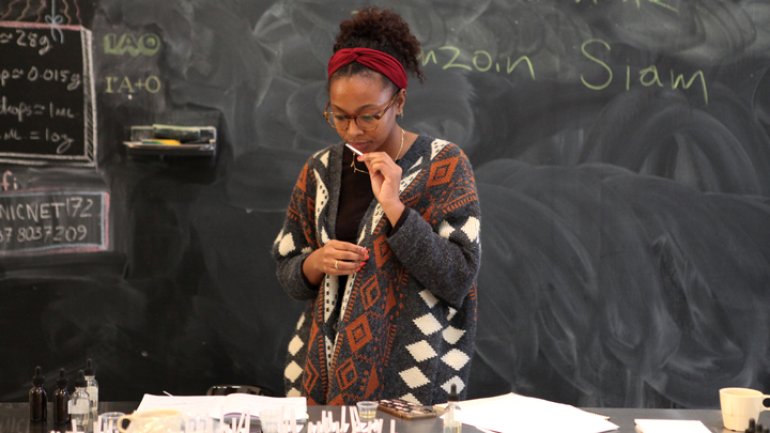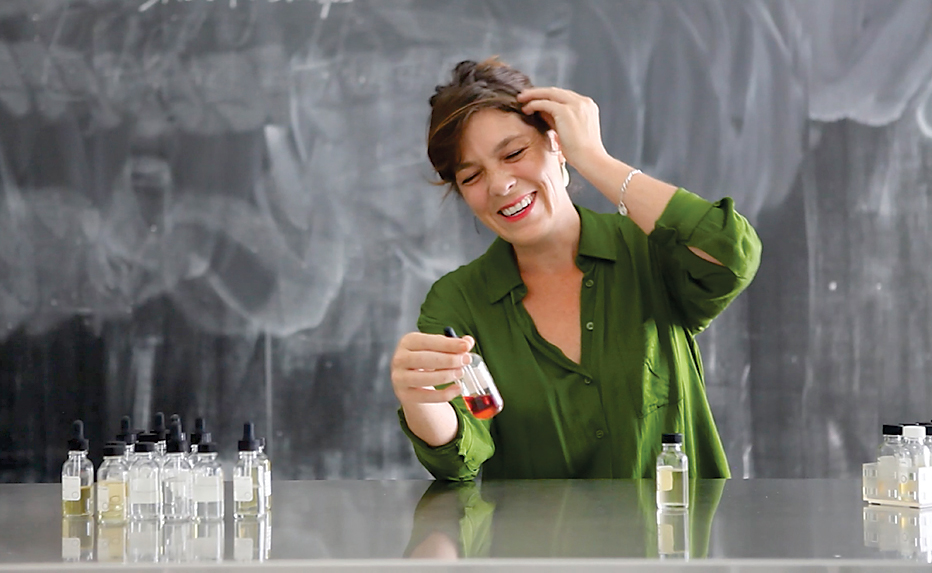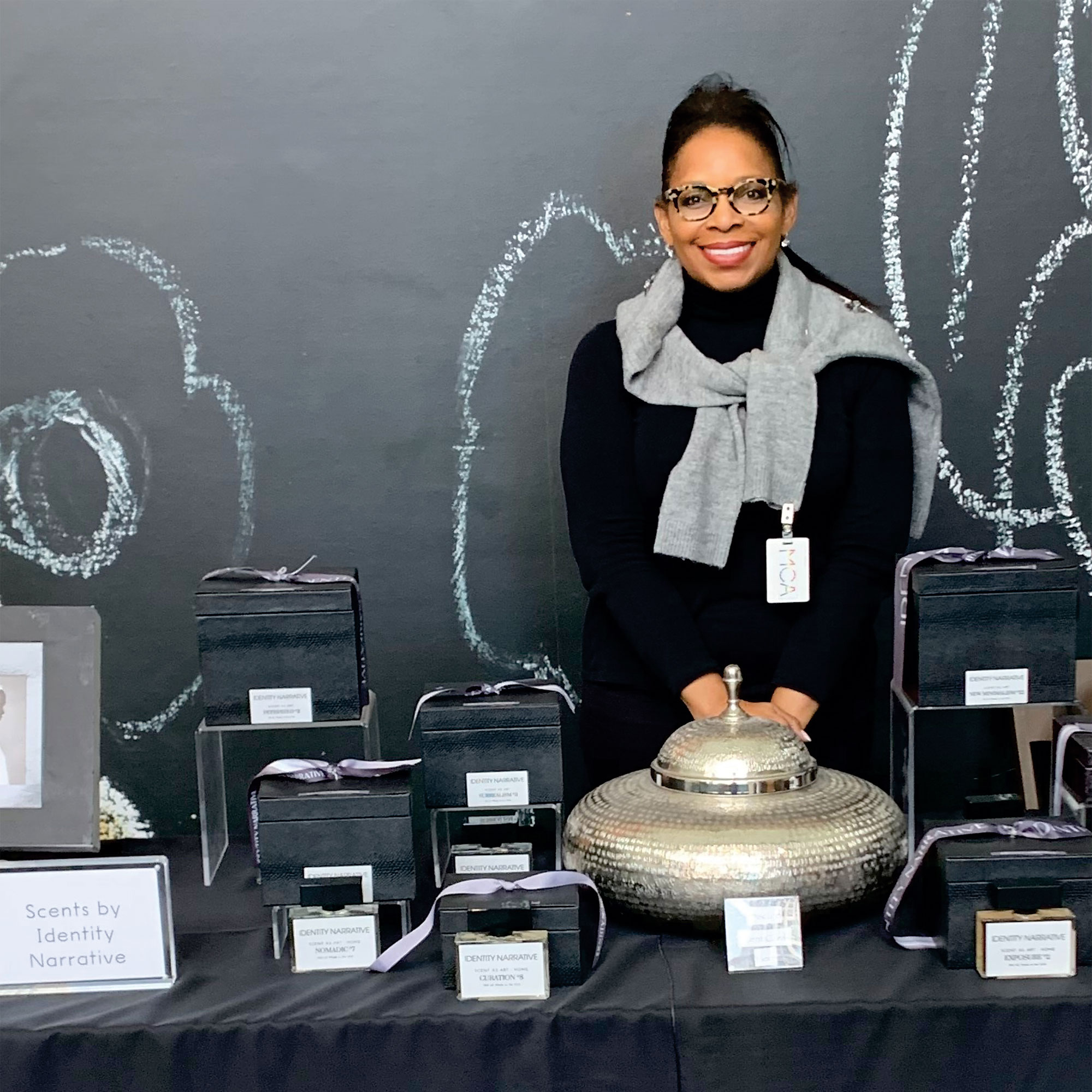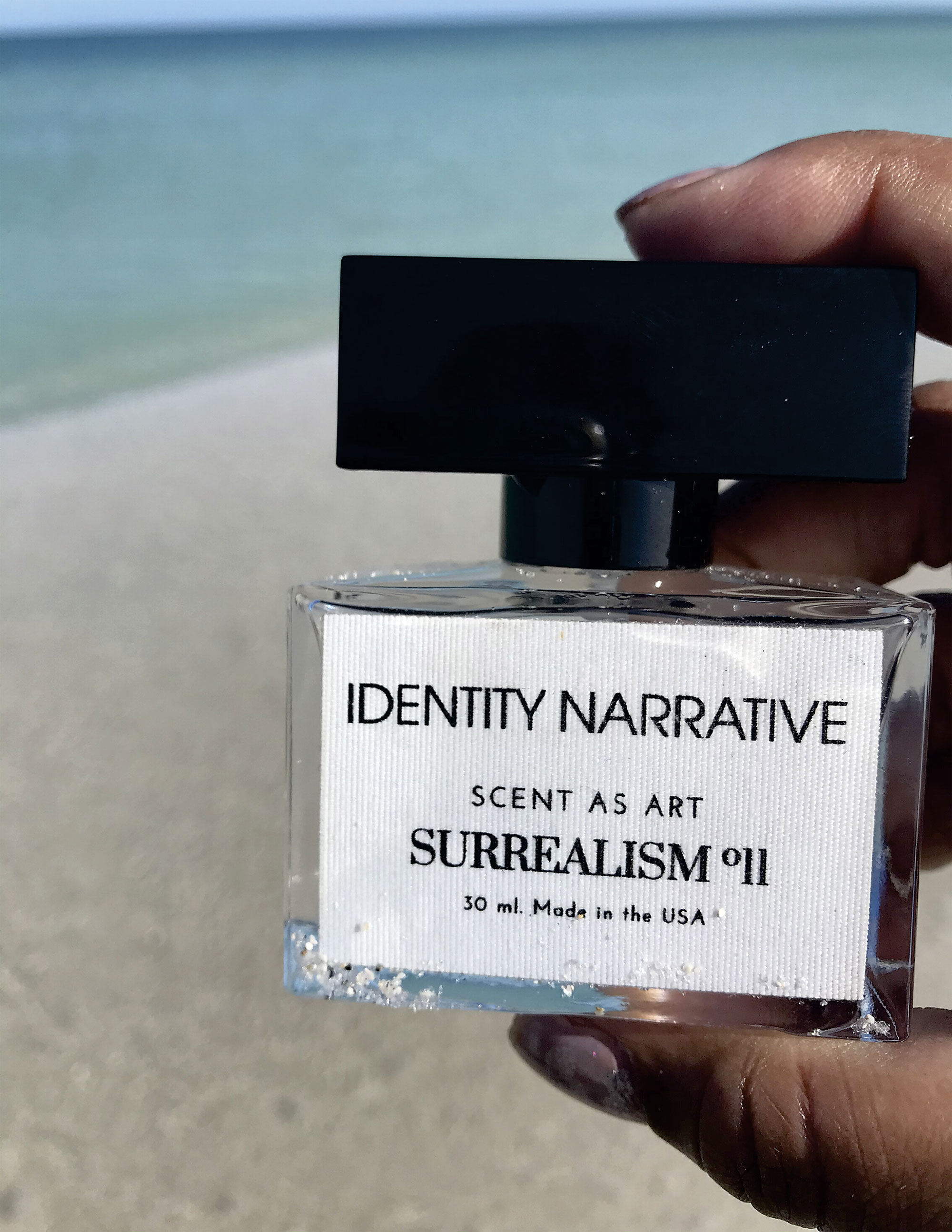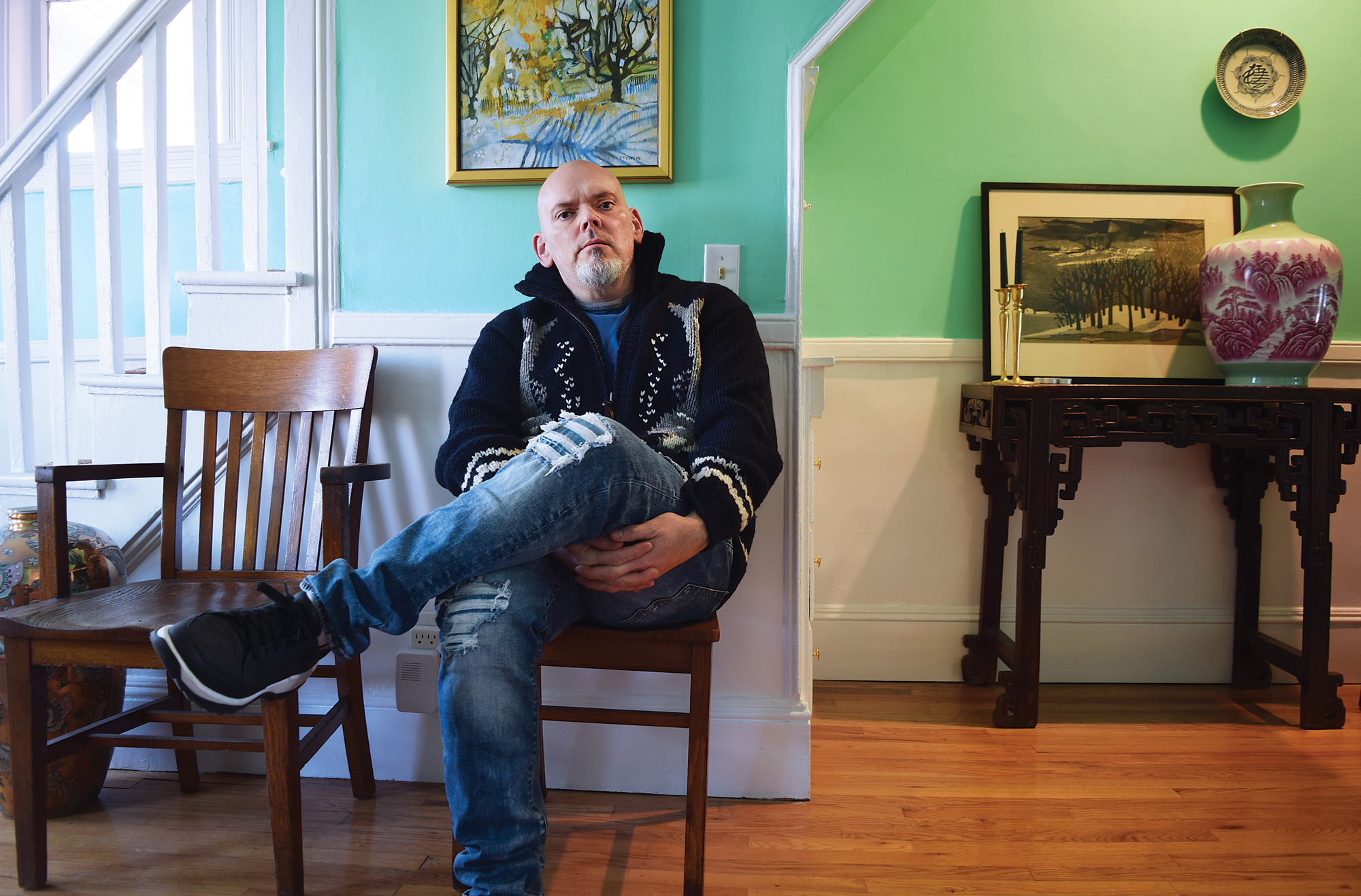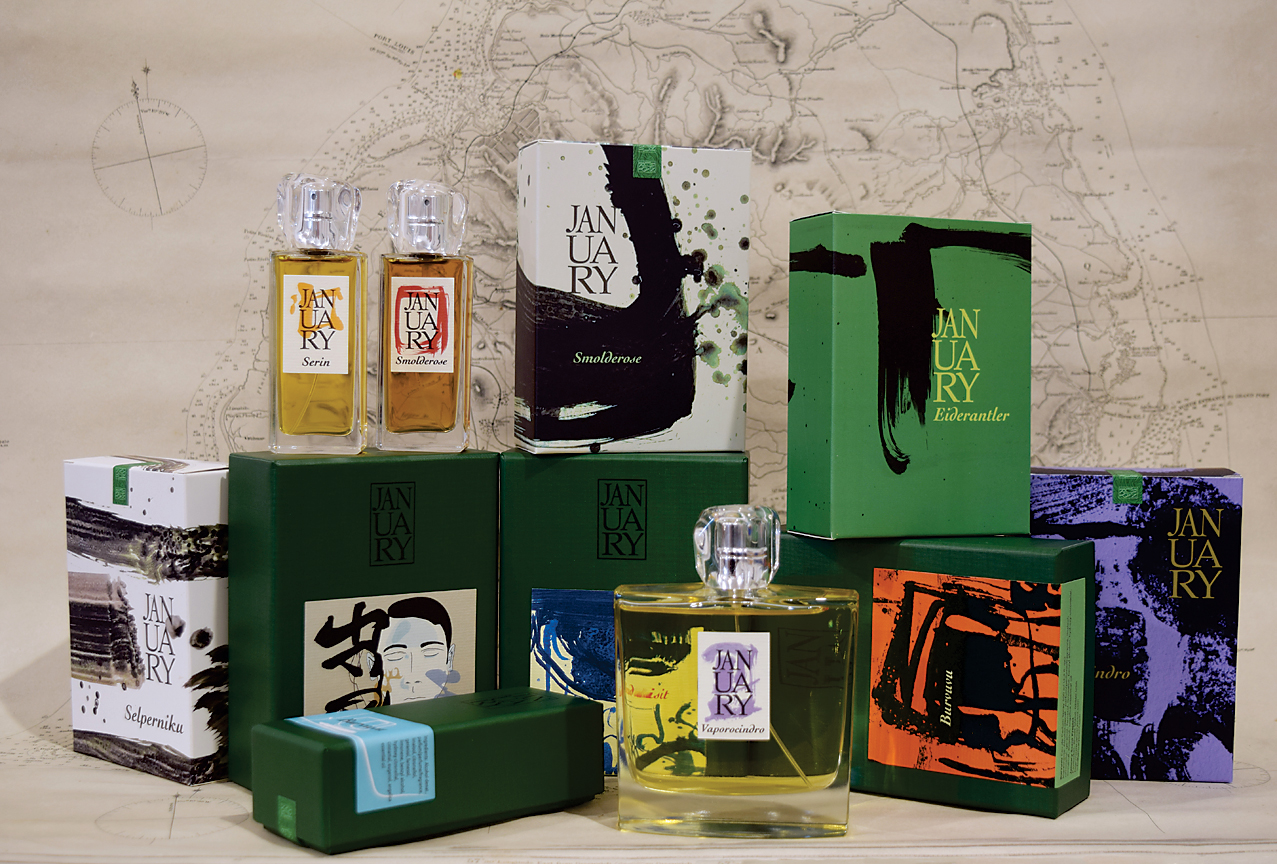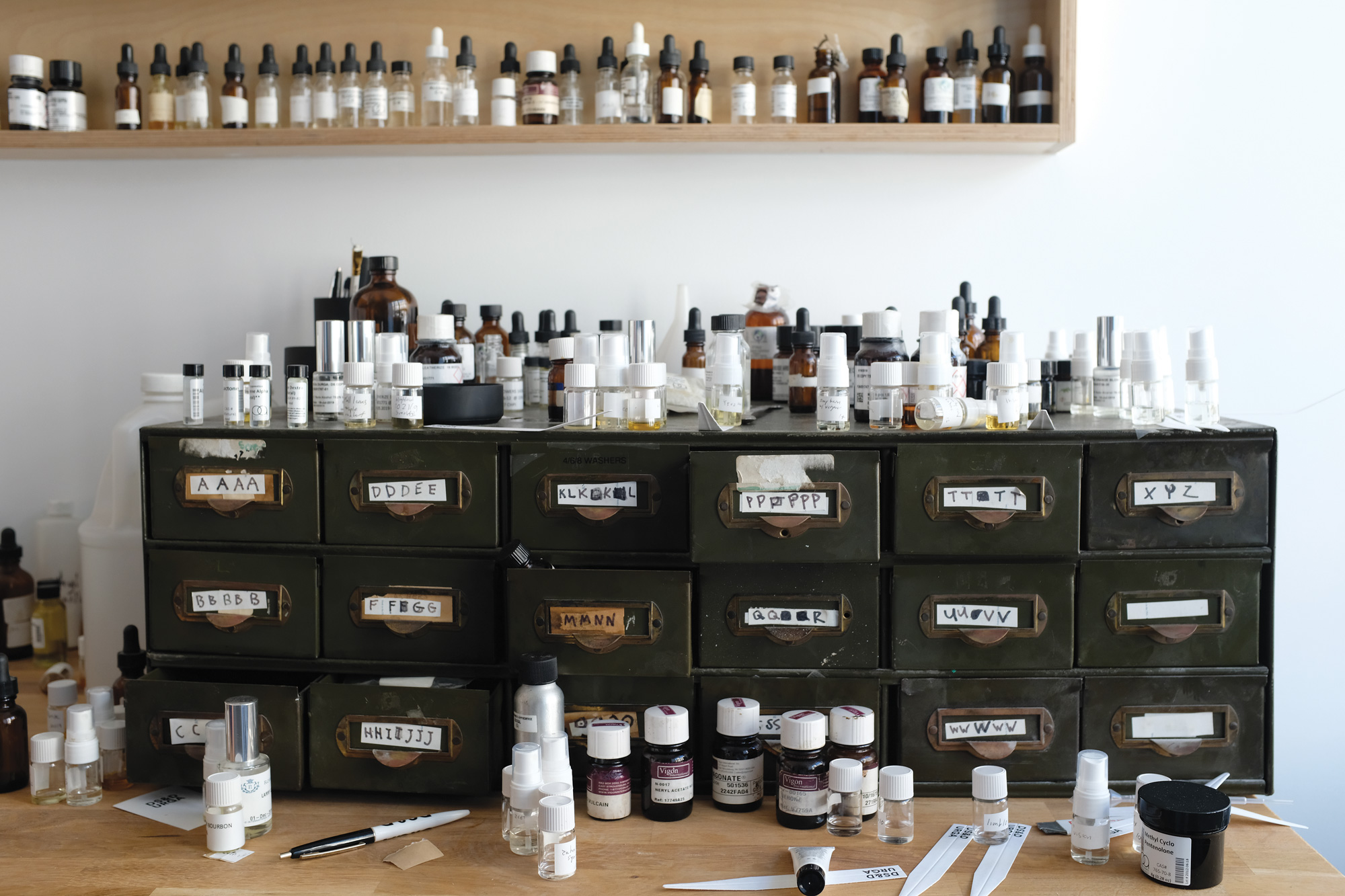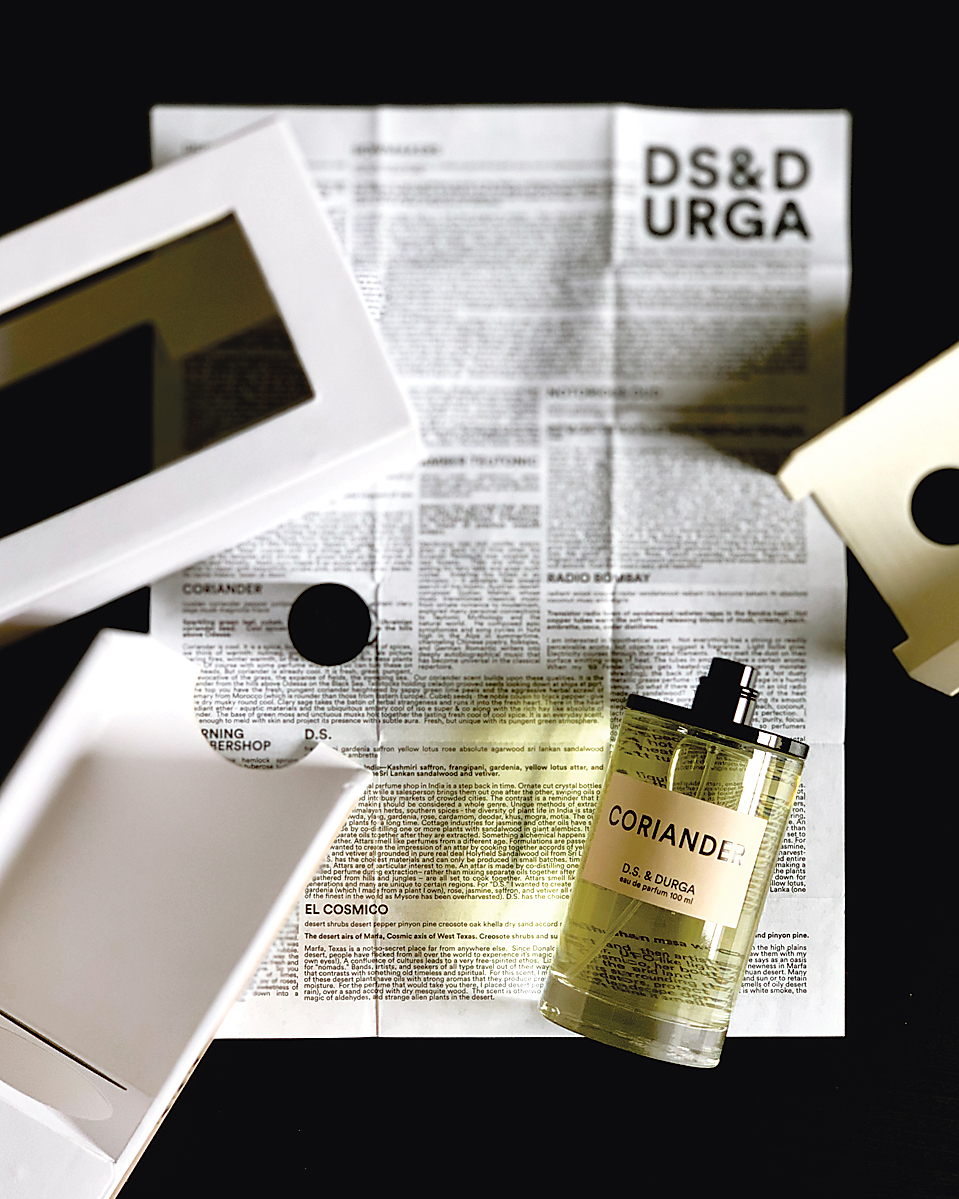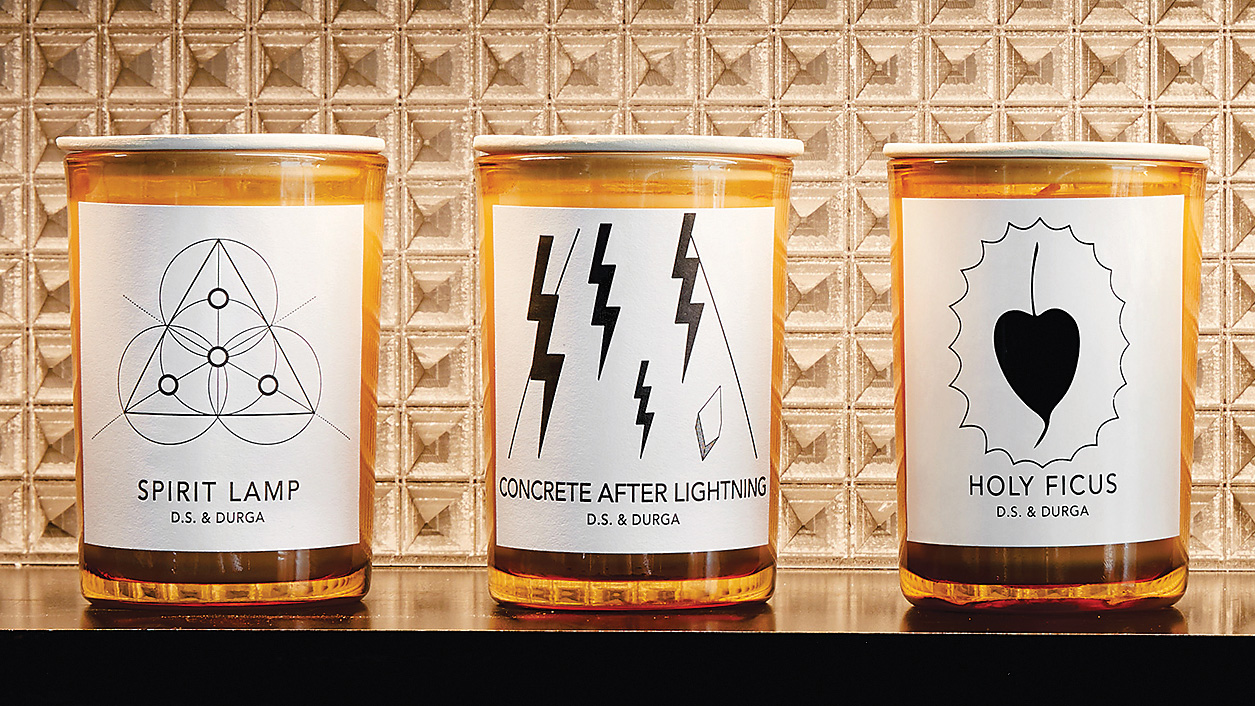The Craft of Scent
The Craft of Scent
↑ A workshop student at the Institute for Art and Olfaction in Los Angeles smells a perfume she made.
Photo: Courtesy of the Institute for Art and Olfaction
Saskia Wilson-Brown is trying, just for fun, to imagine how to create a perfume that evokes a Zoom meeting.
The Los Angeles experimental scent artist and founder of the nonprofit Institute for Art and Olfaction (IAO) says she would start with a word cloud. “I’d probably select digital, ephemeral, and some other words,” she says. “Then I’d figure out what materials I associate with those adjectives.” She would then gather a palette of smells, which can be bought online as essential oils, aromatic molecules, and other derivatives of the materials. “Then, very much like sketching out a painting, I’m trying combinations, writing down my formulas like recipes, and assessing the results – this works, that doesn’t – and making adjustments.”
Using scent strips, pipettes, and beakers, she combines fragrances, and then she sniffs. “I’m going through trial after trial,” she says, “and, in the process, finding out who I am.”
If the idea of a fragrance inspired by a digital experience seems a little off-the-wall, it’s merely a way for Wilson-Brown to indicate how innovative scent-making has become in the 21st century as independent, usually self-taught craft perfumers – cousins to craft brewers, bakers, and other artisans – expand olfactory horizons beyond the classic aromas of great French houses like Guerlain and Chanel.
The idea that scent creation can tell you something about who you are underlines the personalism of the new perfumery, in which, for example, Chicago scent artist Mary Richardson-Lowry can base some of her fragrances on memories of travel in southern Africa, and musician-perfumer David Seth Moltz, working in New York, can liken scent-making to adjusting microphones, filters, and equalization in a recording studio.
“I thought about all the scents of the different herbs, trees, leaves, flowers that I picked up on as I traveled, and about combining those themes into an artistic expression.”
~Mary Richardson-Lowry
John Biebel creates perfumes in a studio in Rhode Island. He’s also a writer who reviews perfumes for the Fragrantica website. “For a long time,” he says, “there was no way for the average person to actually access the raw material. It went directly from the source to a lab to a perfume house. But then the internet saw enough of a need, and some distributors around the world started to buy in bulk and break it down to smaller amounts to sell to craftspeople.”
The point, of course, is olfactory beauty and delight: The power of scent – simple and subtle or complex and powerful – can evoke memories, enliven perceptions, ground us in the moment, or transport us to a new world.
John Biebel, founder of the January Scent Project, is a painter whose interest in the art of scent led him to scent science.
Photos: Courtesy of John Biebel
“I really want to get how these scent molecules actually work.”
~John Biebel
Wilson-Brown’s IAO is dedicated to these experiences, and to the complex craft that can produce them. It supports perfumery experimentation, along with perfume education. She points out that people who are sensitive to perfume may not need to reject it altogether, if they learn which of the many possible elements in it are triggering and which aren’t. And it creates events that highlight the role of scent in art and life. IAO’s first Scent Week – scheduled for September 2020 as of the printing of this issue – promises an abundance of olfactory happenings, including classes in scent blending, studio visits, presentations on perfume history, and scent walks through Los Angeles neighborhoods.
Scent Week is part of what Wilson-Brown considers a sort of olfactory renaissance that’s developing as the sense lodged in our noses claims the same rights as sight, hearing, and touch.
Naturals, Synthetics, and Notes
A landmark event for olfactory art was “The Art of Scent 1889 – 2012,” an exhibition at New York’s Museum of Arts and Design. Curated by Chandler Burr, a journalist and author who was then the museum’s first-ever curator of olfactory art, it presented museumgoers with 12 sleek kiosks, each offering a spritz of a perfume that Burr considers significant in the development of high-end olfactory art.
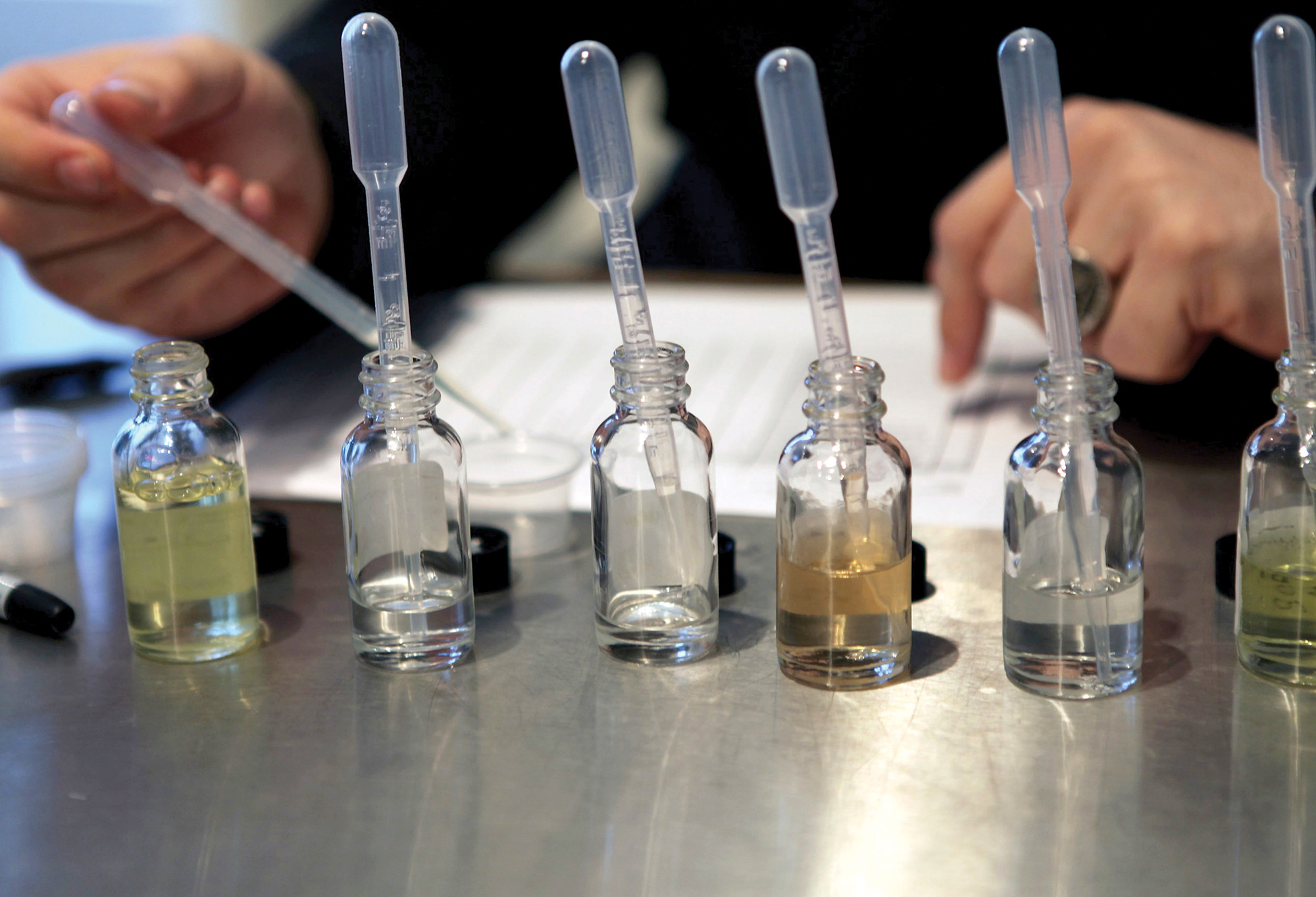
↑ A visitor to the Institute for Art and Olfaction’s weekly open sessions works on a perfume formula.
Photo: Courtesy of the Institute for Art and Olfaction
Burr’s catalogue for the show treats these scents in strictly art-historical terms, labeling them with art movements: The 1889 perfume Jicky by Aimé Guerlain is romanticism, the Angel fragrance by Olivier Cresp (1992) is surrealism, and L’Eau d’Issey, which perfumer Jacques Cavallier created for fashion designer Issey Miyake, is minimalism.
Many of these great perfumes tell a story as they release different fragrance molecules over time. But Miyake wanted Cavallier to create the scent of water, says Burr. “It was done with synthetics, and it was the first real linear perfume – one that didn’t evolve over time.”
To unpack this somewhat cryptic comment, we need to understand the basics of perfume creation and how innovations have expanded its range.
First of all, there’s the distinction between naturals and synthetics. Perfumes have long been crafted from natural plant and animal materials: leaves, fruit rinds, wood, secretions from animal bodies, and so on. The materials are pressed, distilled, processed with carbon dioxide, or otherwise expressed. The result is an aromatic essence with a complex blend of molecules.
Synthetic scents, on the other hand, are single molecules, most often derived from petroleum and created in a lab by chemical reactions. They emerged into perfumery in the late 19th century.
The chemical complexity of the naturals means that they “evolve,” subtly changing their olfactory effect over time. Add multiple naturals together to make a sophisticated fragrance, and you get a complex set of sequences that’s not unlike a narrative, or music, for the nose.
Traditional perfumery actually describes perfume structure as the interaction of three “notes.” The top notes, which you usually pick up when first smelling the perfume, are often citrusy, fresh green, or spicy, and tend to fade away first. The middle notes, which last longer, tend to be heavier spices or light floral aromas: coriander, ylang-ylang, rose, lemongrass, jasmine. The base notes stay longest on the skin. Heavy florals, musks, woody fragrances, and the like are the most frequent bases.
Synthetics, with their simpler chemical structure, “are generally easier to control than naturals,” Burr says. They’ve been a boon to scent crafters, who want a perfume that stays the same as time passes – to create a single mood rather than a story. At the same time, synthetics are regularly mixed with naturals today to obtain a whole galaxy of effects.
“There is a movement toward ‘short formulas,’ a limited number of ingredients, today. But I love crazy, baroque-like, ornate effects in fragrance too.”
~David Seth Moltz
As for Cavallier, Burr’s catalogue explains that he met Miyake’s koan-like challenge by fusing several floral fragrances – both synthetic and natural – into a scent that “has a huge olfactory volume, but is not identifiable. Like water, the scent is pure, still… L’Eau d’Issey opens as if on a single note and continues to hold that note until it simply fades, with no variation in tone, into silence.”
The Makers
To understand what today’s independent scent crafters are doing, we also need to grasp a rough taxonomy of scent and its associations. The IAO’s Basic Perfume Primer lays out 12 “fragrance families” as just one way of organizing the aromas available for perfumes. Among the more interesting are fougère (ferny greenery: lavender, geranium, vetiver, bergamot, oakmoss); gourmand (sweet and delicious: toffee, cognac, chocolate, almonds, vanilla); and ozonic (the air after a thunderstorm: watery, shimmery, bright).
Many of these families come with associations. Fragrances in the floral family have long been major elements of perfumes marketed to women. Evoking the masculine are citrusy fresh aromas, spicy oriental scents (as in Old Spice aftershave), and some of the earthy fougères. But Mary Richardson-Lowry, who creates perfumes under the brand Identity Narrative, is among the new scent artists who make gender-neutral fragrances. “If it’s truly a complete scent, it should embrace the individual, whatever pronoun they use,” she says. Her strategy is to mix the gender markers – some floral, some spice, some citrus – and to balance the aromas so none dominate.
Richardson-Lowry, who’s also a corporate lawyer, the former president of the Chicago Board of Education, and a member of a number of corporate boards, was always fascinated by scent, she says, but it was her global travels that opened her up to creating scents of her own. “I thought about all the scents of the different herbs, trees, leaves, flowers that I picked up on as I traveled, and about combining those themes into an artistic expression.” Art is important to her, and Identity Narrative offers a unique artist-in-residence program in which selected artists and craftspeople, including fabric and ceramic creators, are featured on the company’s website and promotional materials.
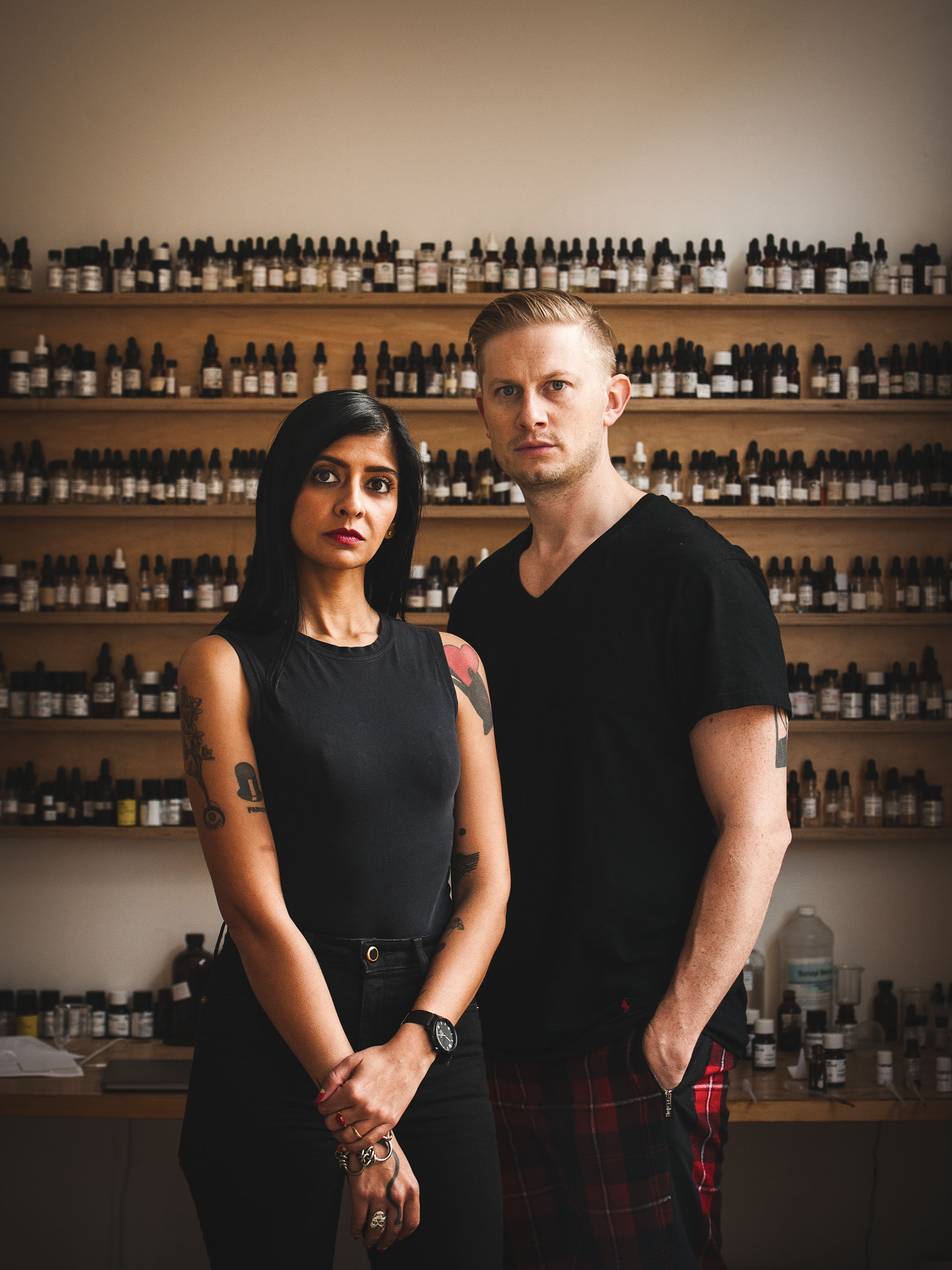
↑ D.S. & Durga is run by the husband-and-wife team of perfumer David Seth Moltz and designer Kavi Ahuja Moltz (aka Durga). The duo sees their work as “translating musical and literary spaces into scent.”
Portrait: Martin Scott Powell
For David Seth Moltz, co-creator with his wife, Kavi, of the D.S. & Durga line of perfumes and other aromatics, music is a passion, so he fully embraces the narrative and musical possibilities of perfume. “As I began learning, I realized that all of the ideas I was thinking about in music I can actually put into fragrance,” he says. “As I learned more, I was able to convey very large narratives the way I would’ve tried in music.”
As in music, or any other craft or art, decisions have to be made about how much is too much; overloading a fragrance can make it muddy, yet Moltz points out that many natural and human-made scents that smell “simple” are really complex blends. One of his own perfumes has 70 elements. “There is a movement toward ‘short formulas,’ a limited number of ingredients, today,” he says, “but I love crazy, baroque-like, ornate effects in fragrance too. It just has to be done right.”
Doing it right involves understanding a good deal of chemistry as well as educating the nose. John Biebel, who creates perfume under the January Scent Project label, began as a painter and then found that the art of scent led him into scent science. “I think this happens a lot with creative disciplines,” he says. “A friend started weaving and then began investigating dyes. I said to her, ‘You’re getting an education in organic chemistry now.’ She said, ‘Yes, and I hated science in school!’ Once you start to actually apply a science to something you’re working on, your desire to understand what’s happening grows. I really want to get how these scent molecules actually work.”
As for Biebel’s own process, it’s very much the trial-and-error that Wilson-Brown described. “I start with a smell I’ve encountered while working that’s pretty interesting,” he says. “I pair this with something else, and then that becomes a more complex idea. Then it starts to evolve a life of its own. I’ll either put it to the side and say, ‘this isn’t really going to go anywhere,’ or ‘wait a minute, this is really starting to get some legs.’”
Biebel likens the process to how he develops a painting: taking a step at a time into the unknown, bolstered by knowledge, but unsure of the result. Scent as art indeed.
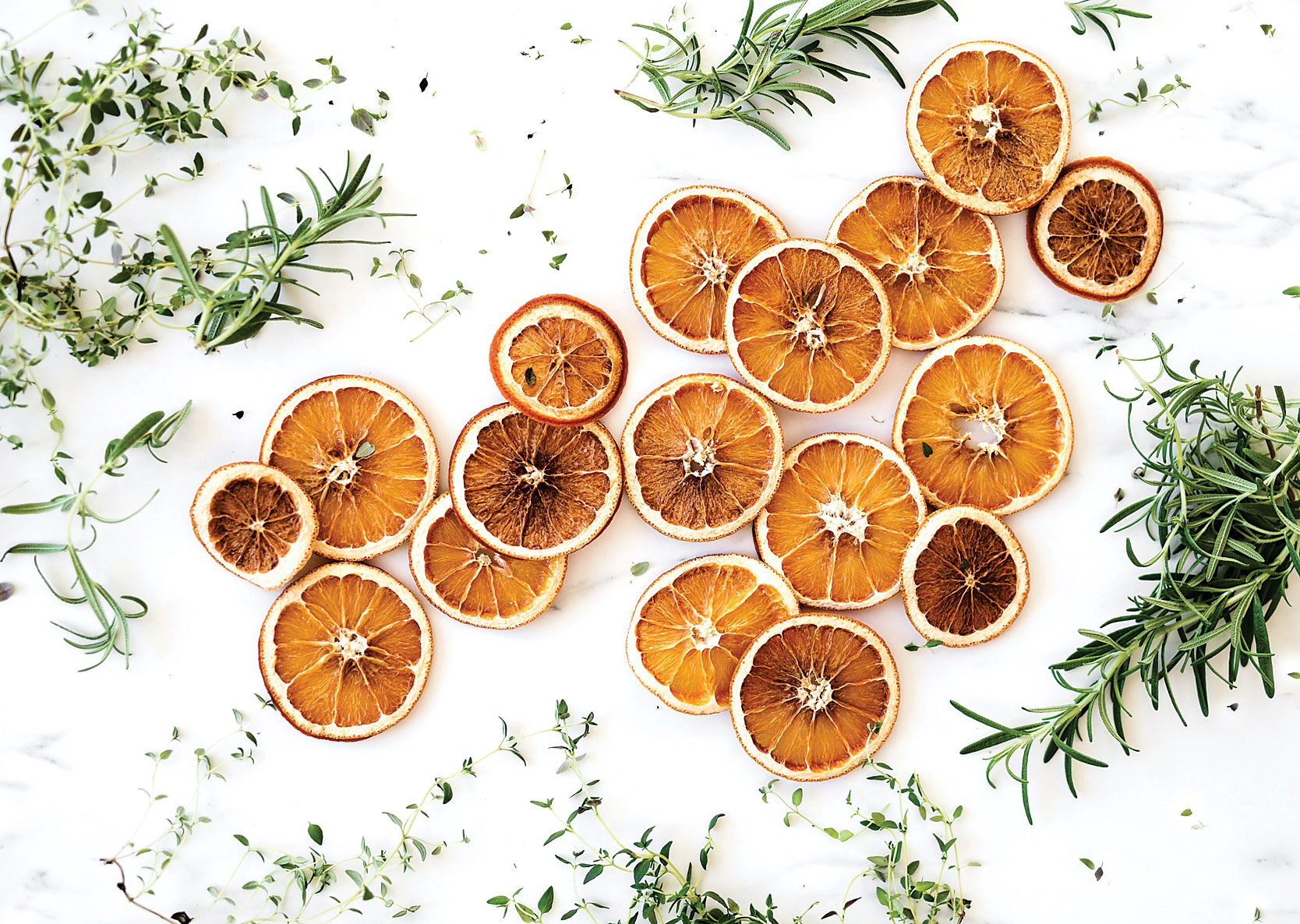
Creating a Beautiful Scent Environment
You can perfume yourself, and you can also perfume your world – that is, create an indoor environment that brings beauty to the nose and peace to the soul. Here are a few ideas.
1) Bring the outdoors in. Collect garden herbs and flowers that give you pleasure and scatter them around the house. “Affluent Romans used to sprinkle rose petals on the floor,” says Saskia Wilson-Brown.
2) Wash or wipe down surfaces with essential oils. Another tip from ancient cultures: They would wash their floors with aromatics, especially lavender oils. You can also wipe down counter or dresser tops with aromatic oils.
3) Let perfume settle on fabrics. Mary Richardson-Lowry suggests misting perfume from an atomizer onto bedsheets. “Don’t spray it directly on them; spray a little above and let it settle,” she suggests. As the weather cools, you can do the same with a lap blanket, a sweater, or a jacket – waft some scent above the fabric and allow it to settle, and it will be subtle and longer-lasting than aiming only to scent the air.
4) Simmer herbs and fruit on the stove. In a small saucepan, bring water to a simmer and add citrus slices and herbs of your choice, such as lavender or mint. The heat will spread the scent.
5) Craft your own room spray. John Biebel suggests combining three parts grapefruit essential oil, two parts pink pepper essential oil, two parts lavender essential oil, and one part patchouli or cedar oil. Mix the oils together and add the mixture to distilled water (about one part oil to five parts water). Put it in a small spray bottle, then spritz for a refreshing alpine scent. Stored in the refrigerator, the mixture will last for about three weeks, Biebel says.
6) Burn a high-quality scented candle. “If you walk into someone’s beautiful mansion and there’s a Glade PlugIns, it just ruins the effect,” says David Moltz. “And then again, if you walk into someone’s very modest apartment and they’re burning a really beautiful frankincense candle, it feels holy and beautiful.”
Do you have a story about an evocative scent?
We'd love to hear from you. Send your reactions, reflections, questions, and concerns to [email protected].
Help us share impactful stories like this one
Become an American Craft Council member and support nonprofit craft publishing. You will not only receive our magazine but also help grow the number of lives craft has touched.


